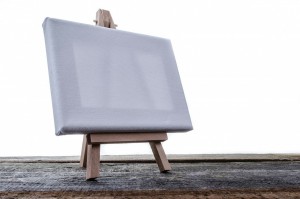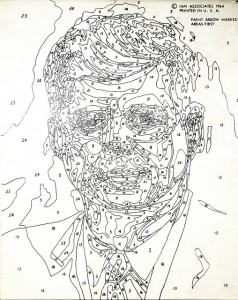
Underlying
An artist was preparing to paint one day. First, she stretched and secured her canvas over its wooden frame. The artist continued by arranging her brushes, planning a colour scheme, and then by setting up her supplies. Finally, it was time to ponder her subject forever to be captured in a moment of time and occupied space – where her vision would be on display in pigment, oil or acrylic for evermore for all to enjoy.
The artist could already see her finished masterpiece. As if the picture had miraculously painted itself. Without anything left to imagine, conjure, or deliberate she began.
Un-(der) inpired
It was all right there in living, er um, cold dead colour. All she had to do was slather it onto the wintery whitewashed space in waiting. She pulled out the widest brush in her kit, dipped it into the first colour, white, and painted a perfectly straight line across the top of the canvas. She dipped her brush again and repeated, the same thing over and over, with the precision of her first strokes until she has covered the entire canvas. She felt satisfied, but did not have time to admire her work for long. There were 29 more canvases to cover just like the first one. She smiled, sighed, dipped her brush, and started on the next one. Yet, with a pallet of colours and brushes at the ready, the artist only knew how to paint with a single brush and to use white paint to do her work.

Under pressure
Does teaching ever seem like this to you? Do educators feel they are asked to paint blank canvases everyday, but are only given one wide brush and a single colour to work with? I wonder whether that is how some teachers have come to feel when a learning system is imposed on them which expects students to be taught to the test?
Teachers plan and prepare their materials to deliver a lesson much like the artist in the story above and in the end are expected to use the broadest brush and one shade of paint. What may be more disappointing, is that many only have time to paint one coat before feeling they have to move on.
Underwhelmed
I am not a huge fan of the traditional textbook. In fact I have called them “knowledge coffins” in the past. When traditional textbooks are at the centre of the instructional day, there is little option for learners to explore beyond its pages. Yes, it’s all in there, but at what cost are other things and ideas being left out?
First, consider the cost of purchasing texts/licenses per class. Math books alone can range upwards of $1500 to $2000 for a class set per subject. What happens when the curriculum gets revamped like what has recently happened in Ontario with the French(2013), Health/Physical Education(2015), and Social Studies(2013). Could the money schools, boards, and government pour into photocopies and textbooks be used to provide Chromebooks for every student instead? Imagine the cost savings in paper alone. If we did this, every learner from K to 12 could be equipped with a productivity and research tool for the classroom at their fingertips? And, at home too if WiFi is available.
Unrepentant
I am a fan of adaptive and hands on learning environments. In the classroom, I want students to have a voice in how and what they are being taught so we can democratize education. I believe all educators possess the means/ability to transform and tailor their instruction to suit their students. What they need now is a safe place to do so and that’s an issue of system and school leadership.

To paint a portrait of the future, educators need to use the prescribed curriculum as a pallet filled with colours that is not limited to a paint-by-number task. However, many are afraid to use other, less traditional brushes and materials to paint their masterpieces because the outcomes might not look resemble or match work gathering dust on the walls.
Yes, there are things to be taken from the past, but the world outside our classrooms has not remained fixed in space and time. Neither should it remain static inside. The classroom must become a vibrant and connected place where students have access to, and be able to contribute to a world of knowledge.
This requires courage to happen. It requires time for others to understand, accept, and embrace. It doesn’t have to look perfect. The mess is an important part of the process.
Ask yourself what or who inspires you to take chances as a learner? What new idea(s) would you try in your classroom if you knew you couldn’t fail? Start by giving yourself permission to change things up in one subject area, and then go from there.
I’ll be here to chat if you want to talk more about how we can change the portrait of education to a landscape of creativity, differentiation, and encouragement.
In the meantime I have some brushes to clean.
